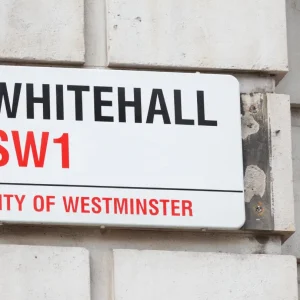
Unlike most government chief information officers, arranging an interview with Siim Sikkut does not involve a toing and froing of emails with communications departments or vetting questions in advance.
“First of all, we can’t imagine otherwise, we value these direct contacts so much,” says Sikkut, government CIO at Estonia’s Ministry of Economic Affairs and Communications. “And secondly, there’s not so many of us to have too many middlemen and women!”
The transparency that Estonia’s small scale allows – with 1.3m inhabitants, its population density is among the lowest in Europe – is essential to its famously digital government, Sikkut explains. “Otherwise we couldn’t run the digital government that we run,” he adds. “It also helps to attract the next guys to work with us.”

Siim Sikkut, Estonia’s government CIO, launching the Digital Testbed Framwork during the Tallinn Digital Summit in September 2021. (Photo by Aron Urb)
Now, Estonia is preparing to take open government innovation to the next level, with a Digital Testbed Framework that invites start-ups and other innovators to access and reuse its digital platforms. It is the next step for the digital government agenda in Estonia, a country where every public administrative procedure – except for marriages and divorces – can be conducted online.
Sikkut officially unveiled the Framework at the recent Tallinn Digital Summit, where policymakers from around the world gathered to develop ‘Trusted Connectivity’ guidelines for digital infrastructure and cross-border data flows. The Digital Testbed Framework (DTF) – which Estonia has dubbed a ‘country-sized hackathon‘ – allows innovators from around the world to access the technology that underpins its digital government services.
It is a scaled-up version of a domestic programme – the “digigov ‘playground’ legal framework” – that has been used to develop 12 pilot solutions. These include an open-source speech recognition application used by the Estonian parliament and an AI text analytics tool used by the Ministry of Justice. It was also used by the Estonian Health Board to create the country’s official Covid-19 test-and-trace notification app.
The DTF removes a “legal bottleneck” so that international partners can now participate, Sikkut says. “We are living in a world of public tender procurements,” he explains. “We can’t give state aid, we can’t [give] unfair advantage to any company. So we had to figure out the framework, basically the agreement, that we would make with the testbed partners, that basically handles those risks in a way, saying, ‘look, it’s open, the outcome will be freely reusable by everyone’.”
The scheme is directed primarily at start-ups, Sikkut says. These smaller companies are often detached from government, he explains, and the DTF is an attempt to bridge that gap. But “anyone is welcome”, he said during the launch, including big companies, other governments, international humanitarian organisations and researchers with “cool ideas”.
Estonia and its Digital Testbed Framework: what’s on offer?
Organisations that participate in the DTF get access to the Estonian central government’s digital platforms – its so-called ‘digigov stack’, which includes digital identity and blockchain-based data security – as well as its digital know-how and open data. If the solution they develop using these resources is successful, the partners have a proof-of-concept, a road-tested product, and the Estonian government as a reference customer. “We’ll promote the hell out of you,” Sikkut said during the DTF’s official announcement.
In return, the government gets free access to a new digital solution, which will be part of the publicly available source code repository. There are no financial commitments from either side, and private sector partners are free to sell the products they develop as part of the framework. The only stipulation is that they must enter a public-private partnership with the Estonian government.
Although the scheme has just launched, Sikkut says it has already received dozens of applications: “We’ll wait for the whole batch to come in and then work on the ensemble.” There is no limit to the number of applications he and his team will take in, he adds, as they will consider any proposals that have the potential to offer a solution to the problems that government agencies are currently experiencing.
“Think of it as a sort of investment pipeline,” Sikkut explains. “You have a lot of stuff coming in, you filter some of the stuff out and some become a concrete solution in the end.”
Sikkut and his team hope that the DTF will bring a fresh wave of innovative solutions to the Estonian public sector that can take e-Estonia to the next level. “If we have a match between what you propose and what we need […], from the Estonian government side we get the next great addition to the digital government for free. You get an approved solution that you can take to the wide world and, believe me, there are many countries looking forward to you bringing [that solution] to them.”







